HAT304 - Aging Tourism: Analysis of Touchpoints & Solutions
VerifiedAdded on 2023/06/12
|6
|1489
|171
Report
AI Summary
This report examines the growing trend of aging tourism, focusing on various segments within the aging population, including the Silent Generation, "New Age" Elderly, Seniors, and Baby Boomers, and their distinct travel preferences. It identifies key touchpoints for these travelers, such as drive tourism (including recreational vehicle travel and caravanning), cruise travel, accessible tourism, and virtual reality travel. The report analyzes the central issues affecting each touchpoint, including cost, health considerations, and infrastructural requirements. It also proposes potential solutions, such as government incentives, to mitigate these challenges. The analysis utilizes recent scholarly literature to provide an informed perspective on the evolving landscape of aging tourism and its implications for the hospitality industry.
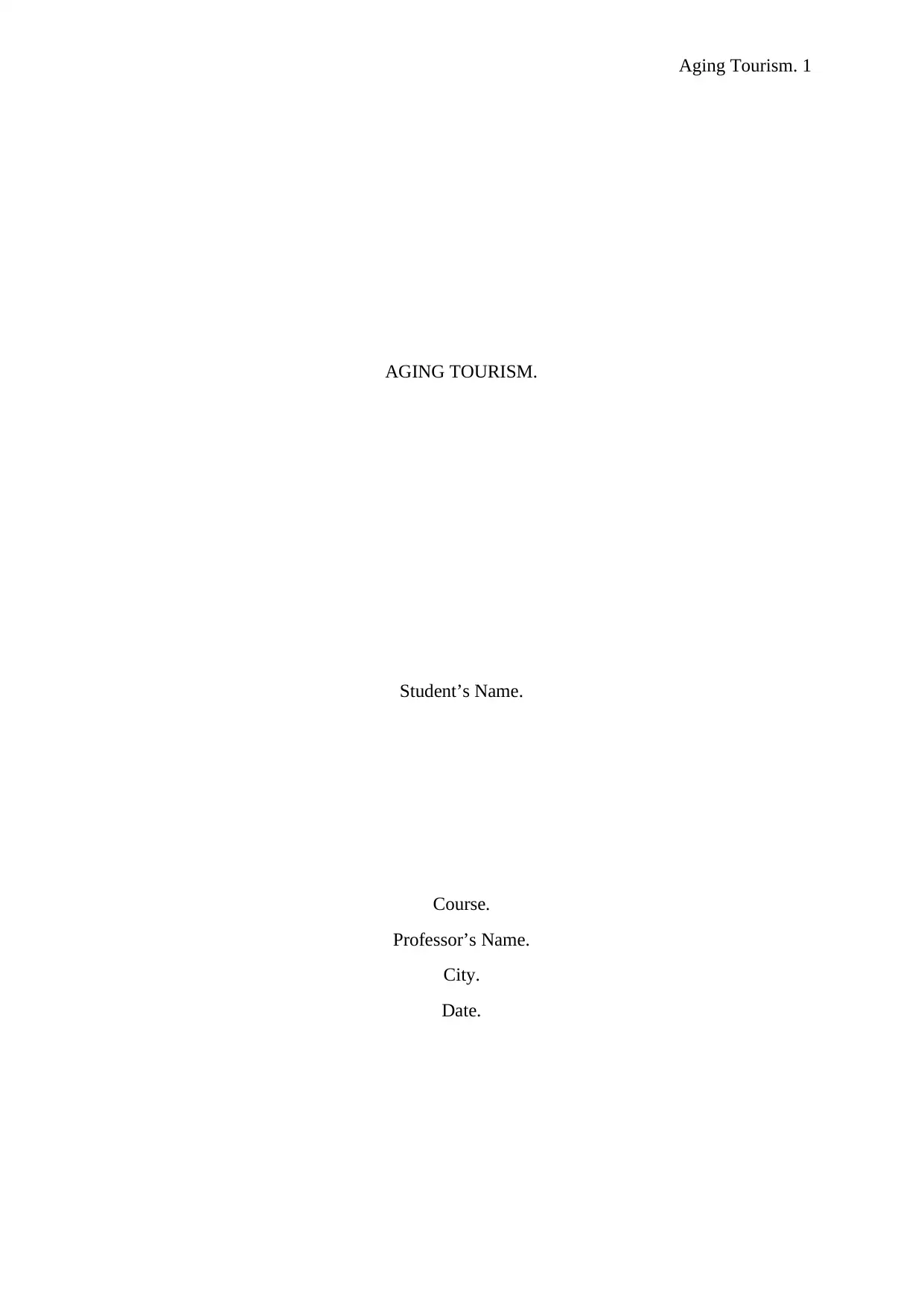
Aging Tourism. 1
AGING TOURISM.
Student’s Name.
Course.
Professor’s Name.
City.
Date.
AGING TOURISM.
Student’s Name.
Course.
Professor’s Name.
City.
Date.
Paraphrase This Document
Need a fresh take? Get an instant paraphrase of this document with our AI Paraphraser
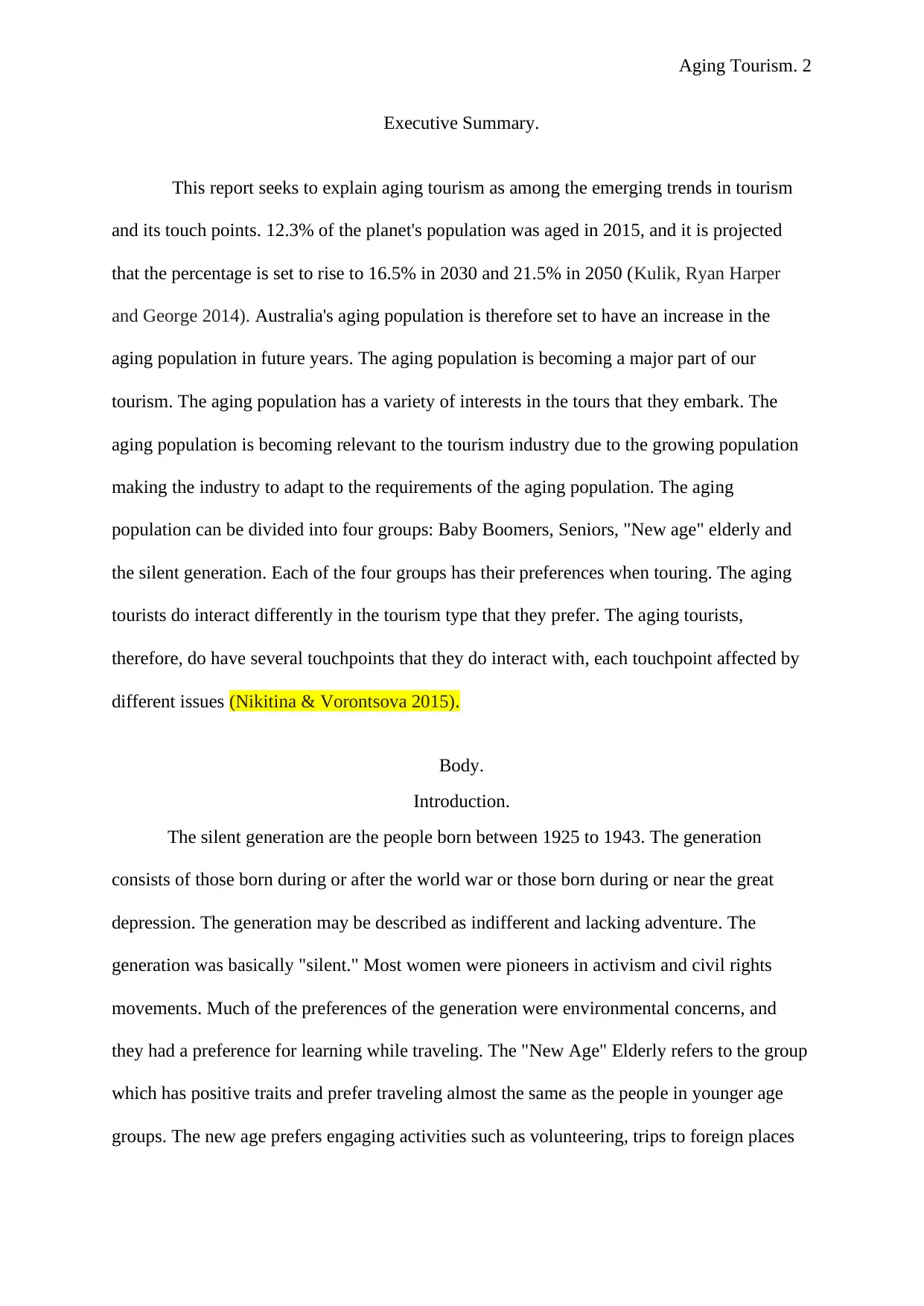
Aging Tourism. 2
Executive Summary.
This report seeks to explain aging tourism as among the emerging trends in tourism
and its touch points. 12.3% of the planet's population was aged in 2015, and it is projected
that the percentage is set to rise to 16.5% in 2030 and 21.5% in 2050 (Kulik, Ryan Harper
and George 2014). Australia's aging population is therefore set to have an increase in the
aging population in future years. The aging population is becoming a major part of our
tourism. The aging population has a variety of interests in the tours that they embark. The
aging population is becoming relevant to the tourism industry due to the growing population
making the industry to adapt to the requirements of the aging population. The aging
population can be divided into four groups: Baby Boomers, Seniors, "New age" elderly and
the silent generation. Each of the four groups has their preferences when touring. The aging
tourists do interact differently in the tourism type that they prefer. The aging tourists,
therefore, do have several touchpoints that they do interact with, each touchpoint affected by
different issues (Nikitina & Vorontsova 2015).
Body.
Introduction.
The silent generation are the people born between 1925 to 1943. The generation
consists of those born during or after the world war or those born during or near the great
depression. The generation may be described as indifferent and lacking adventure. The
generation was basically "silent." Most women were pioneers in activism and civil rights
movements. Much of the preferences of the generation were environmental concerns, and
they had a preference for learning while traveling. The "New Age" Elderly refers to the group
which has positive traits and prefer traveling almost the same as the people in younger age
groups. The new age prefers engaging activities such as volunteering, trips to foreign places
Executive Summary.
This report seeks to explain aging tourism as among the emerging trends in tourism
and its touch points. 12.3% of the planet's population was aged in 2015, and it is projected
that the percentage is set to rise to 16.5% in 2030 and 21.5% in 2050 (Kulik, Ryan Harper
and George 2014). Australia's aging population is therefore set to have an increase in the
aging population in future years. The aging population is becoming a major part of our
tourism. The aging population has a variety of interests in the tours that they embark. The
aging population is becoming relevant to the tourism industry due to the growing population
making the industry to adapt to the requirements of the aging population. The aging
population can be divided into four groups: Baby Boomers, Seniors, "New age" elderly and
the silent generation. Each of the four groups has their preferences when touring. The aging
tourists do interact differently in the tourism type that they prefer. The aging tourists,
therefore, do have several touchpoints that they do interact with, each touchpoint affected by
different issues (Nikitina & Vorontsova 2015).
Body.
Introduction.
The silent generation are the people born between 1925 to 1943. The generation
consists of those born during or after the world war or those born during or near the great
depression. The generation may be described as indifferent and lacking adventure. The
generation was basically "silent." Most women were pioneers in activism and civil rights
movements. Much of the preferences of the generation were environmental concerns, and
they had a preference for learning while traveling. The "New Age" Elderly refers to the group
which has positive traits and prefer traveling almost the same as the people in younger age
groups. The new age prefers engaging activities such as volunteering, trips to foreign places
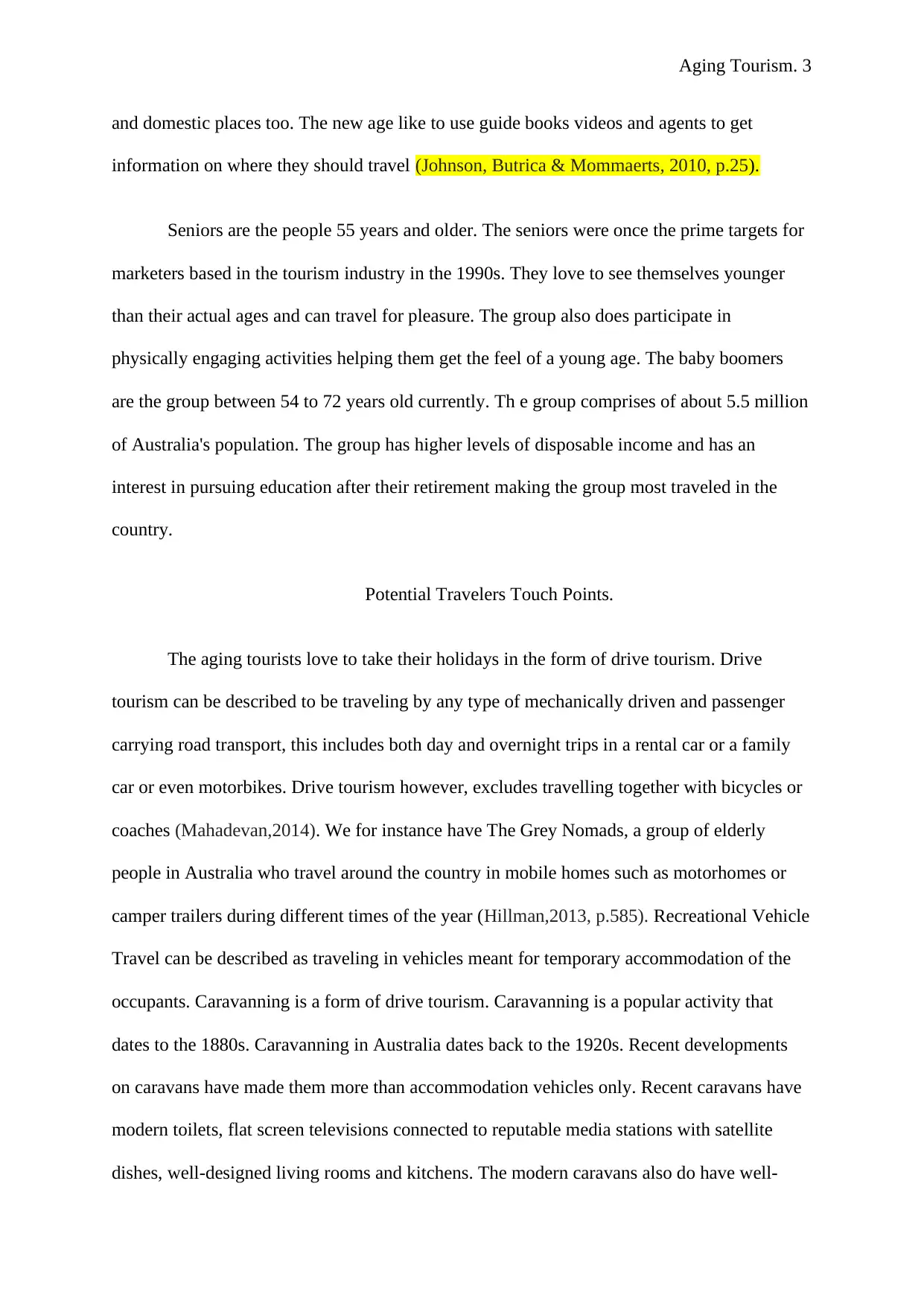
Aging Tourism. 3
and domestic places too. The new age like to use guide books videos and agents to get
information on where they should travel (Johnson, Butrica & Mommaerts, 2010, p.25).
Seniors are the people 55 years and older. The seniors were once the prime targets for
marketers based in the tourism industry in the 1990s. They love to see themselves younger
than their actual ages and can travel for pleasure. The group also does participate in
physically engaging activities helping them get the feel of a young age. The baby boomers
are the group between 54 to 72 years old currently. Th e group comprises of about 5.5 million
of Australia's population. The group has higher levels of disposable income and has an
interest in pursuing education after their retirement making the group most traveled in the
country.
Potential Travelers Touch Points.
The aging tourists love to take their holidays in the form of drive tourism. Drive
tourism can be described to be traveling by any type of mechanically driven and passenger
carrying road transport, this includes both day and overnight trips in a rental car or a family
car or even motorbikes. Drive tourism however, excludes travelling together with bicycles or
coaches (Mahadevan,2014). We for instance have The Grey Nomads, a group of elderly
people in Australia who travel around the country in mobile homes such as motorhomes or
camper trailers during different times of the year (Hillman,2013, p.585). Recreational Vehicle
Travel can be described as traveling in vehicles meant for temporary accommodation of the
occupants. Caravanning is a form of drive tourism. Caravanning is a popular activity that
dates to the 1880s. Caravanning in Australia dates back to the 1920s. Recent developments
on caravans have made them more than accommodation vehicles only. Recent caravans have
modern toilets, flat screen televisions connected to reputable media stations with satellite
dishes, well-designed living rooms and kitchens. The modern caravans also do have well-
and domestic places too. The new age like to use guide books videos and agents to get
information on where they should travel (Johnson, Butrica & Mommaerts, 2010, p.25).
Seniors are the people 55 years and older. The seniors were once the prime targets for
marketers based in the tourism industry in the 1990s. They love to see themselves younger
than their actual ages and can travel for pleasure. The group also does participate in
physically engaging activities helping them get the feel of a young age. The baby boomers
are the group between 54 to 72 years old currently. Th e group comprises of about 5.5 million
of Australia's population. The group has higher levels of disposable income and has an
interest in pursuing education after their retirement making the group most traveled in the
country.
Potential Travelers Touch Points.
The aging tourists love to take their holidays in the form of drive tourism. Drive
tourism can be described to be traveling by any type of mechanically driven and passenger
carrying road transport, this includes both day and overnight trips in a rental car or a family
car or even motorbikes. Drive tourism however, excludes travelling together with bicycles or
coaches (Mahadevan,2014). We for instance have The Grey Nomads, a group of elderly
people in Australia who travel around the country in mobile homes such as motorhomes or
camper trailers during different times of the year (Hillman,2013, p.585). Recreational Vehicle
Travel can be described as traveling in vehicles meant for temporary accommodation of the
occupants. Caravanning is a form of drive tourism. Caravanning is a popular activity that
dates to the 1880s. Caravanning in Australia dates back to the 1920s. Recent developments
on caravans have made them more than accommodation vehicles only. Recent caravans have
modern toilets, flat screen televisions connected to reputable media stations with satellite
dishes, well-designed living rooms and kitchens. The modern caravans also do have well-
⊘ This is a preview!⊘
Do you want full access?
Subscribe today to unlock all pages.

Trusted by 1+ million students worldwide
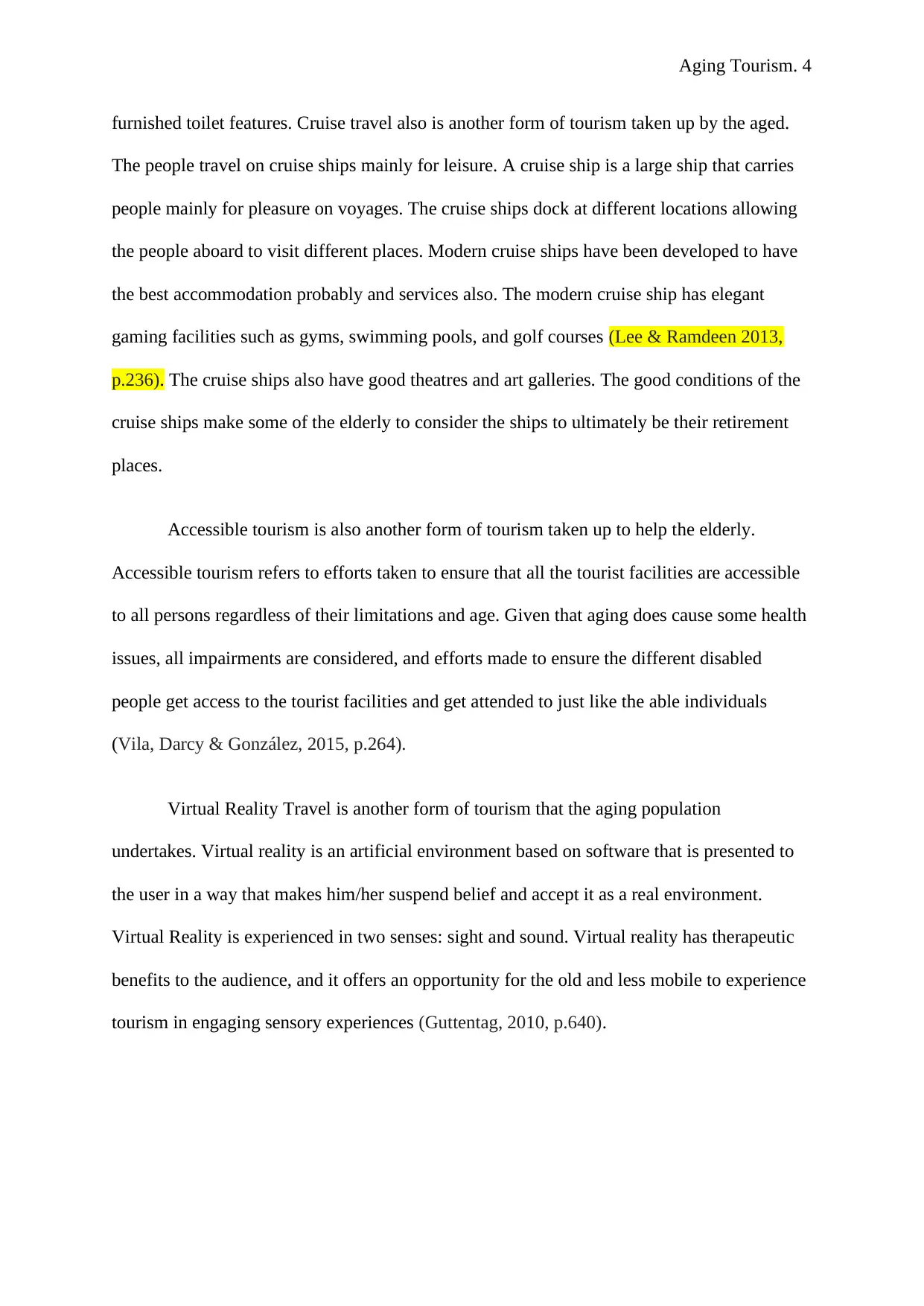
Aging Tourism. 4
furnished toilet features. Cruise travel also is another form of tourism taken up by the aged.
The people travel on cruise ships mainly for leisure. A cruise ship is a large ship that carries
people mainly for pleasure on voyages. The cruise ships dock at different locations allowing
the people aboard to visit different places. Modern cruise ships have been developed to have
the best accommodation probably and services also. The modern cruise ship has elegant
gaming facilities such as gyms, swimming pools, and golf courses (Lee & Ramdeen 2013,
p.236). The cruise ships also have good theatres and art galleries. The good conditions of the
cruise ships make some of the elderly to consider the ships to ultimately be their retirement
places.
Accessible tourism is also another form of tourism taken up to help the elderly.
Accessible tourism refers to efforts taken to ensure that all the tourist facilities are accessible
to all persons regardless of their limitations and age. Given that aging does cause some health
issues, all impairments are considered, and efforts made to ensure the different disabled
people get access to the tourist facilities and get attended to just like the able individuals
(Vila, Darcy & González, 2015, p.264).
Virtual Reality Travel is another form of tourism that the aging population
undertakes. Virtual reality is an artificial environment based on software that is presented to
the user in a way that makes him/her suspend belief and accept it as a real environment.
Virtual Reality is experienced in two senses: sight and sound. Virtual reality has therapeutic
benefits to the audience, and it offers an opportunity for the old and less mobile to experience
tourism in engaging sensory experiences (Guttentag, 2010, p.640).
furnished toilet features. Cruise travel also is another form of tourism taken up by the aged.
The people travel on cruise ships mainly for leisure. A cruise ship is a large ship that carries
people mainly for pleasure on voyages. The cruise ships dock at different locations allowing
the people aboard to visit different places. Modern cruise ships have been developed to have
the best accommodation probably and services also. The modern cruise ship has elegant
gaming facilities such as gyms, swimming pools, and golf courses (Lee & Ramdeen 2013,
p.236). The cruise ships also have good theatres and art galleries. The good conditions of the
cruise ships make some of the elderly to consider the ships to ultimately be their retirement
places.
Accessible tourism is also another form of tourism taken up to help the elderly.
Accessible tourism refers to efforts taken to ensure that all the tourist facilities are accessible
to all persons regardless of their limitations and age. Given that aging does cause some health
issues, all impairments are considered, and efforts made to ensure the different disabled
people get access to the tourist facilities and get attended to just like the able individuals
(Vila, Darcy & González, 2015, p.264).
Virtual Reality Travel is another form of tourism that the aging population
undertakes. Virtual reality is an artificial environment based on software that is presented to
the user in a way that makes him/her suspend belief and accept it as a real environment.
Virtual Reality is experienced in two senses: sight and sound. Virtual reality has therapeutic
benefits to the audience, and it offers an opportunity for the old and less mobile to experience
tourism in engaging sensory experiences (Guttentag, 2010, p.640).
Paraphrase This Document
Need a fresh take? Get an instant paraphrase of this document with our AI Paraphraser
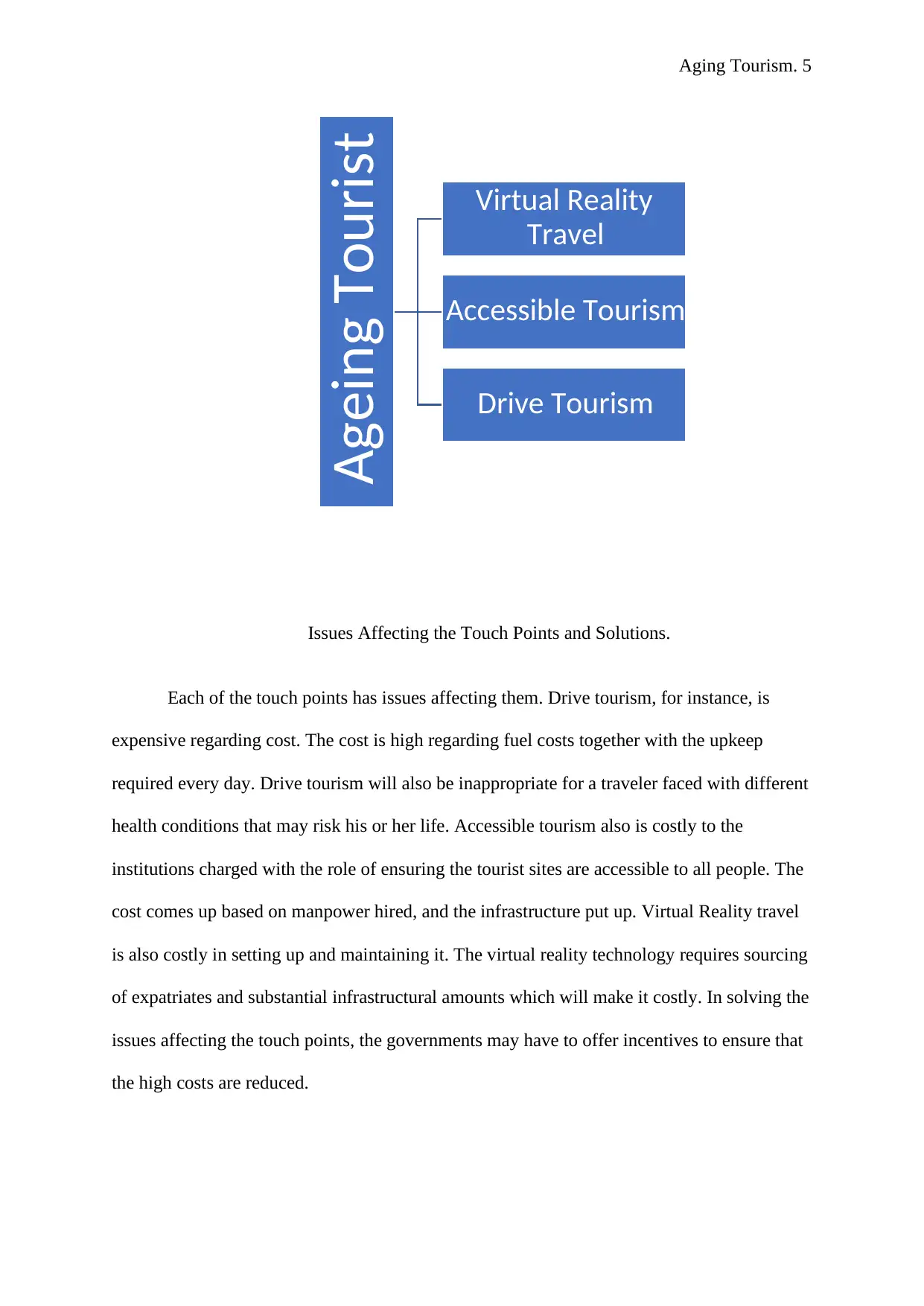
Aging Tourism. 5
Issues Affecting the Touch Points and Solutions.
Each of the touch points has issues affecting them. Drive tourism, for instance, is
expensive regarding cost. The cost is high regarding fuel costs together with the upkeep
required every day. Drive tourism will also be inappropriate for a traveler faced with different
health conditions that may risk his or her life. Accessible tourism also is costly to the
institutions charged with the role of ensuring the tourist sites are accessible to all people. The
cost comes up based on manpower hired, and the infrastructure put up. Virtual Reality travel
is also costly in setting up and maintaining it. The virtual reality technology requires sourcing
of expatriates and substantial infrastructural amounts which will make it costly. In solving the
issues affecting the touch points, the governments may have to offer incentives to ensure that
the high costs are reduced.
Ageing Tourist
Virtual Reality
Travel
Accessible Tourism
Drive Tourism
Issues Affecting the Touch Points and Solutions.
Each of the touch points has issues affecting them. Drive tourism, for instance, is
expensive regarding cost. The cost is high regarding fuel costs together with the upkeep
required every day. Drive tourism will also be inappropriate for a traveler faced with different
health conditions that may risk his or her life. Accessible tourism also is costly to the
institutions charged with the role of ensuring the tourist sites are accessible to all people. The
cost comes up based on manpower hired, and the infrastructure put up. Virtual Reality travel
is also costly in setting up and maintaining it. The virtual reality technology requires sourcing
of expatriates and substantial infrastructural amounts which will make it costly. In solving the
issues affecting the touch points, the governments may have to offer incentives to ensure that
the high costs are reduced.
Ageing Tourist
Virtual Reality
Travel
Accessible Tourism
Drive Tourism
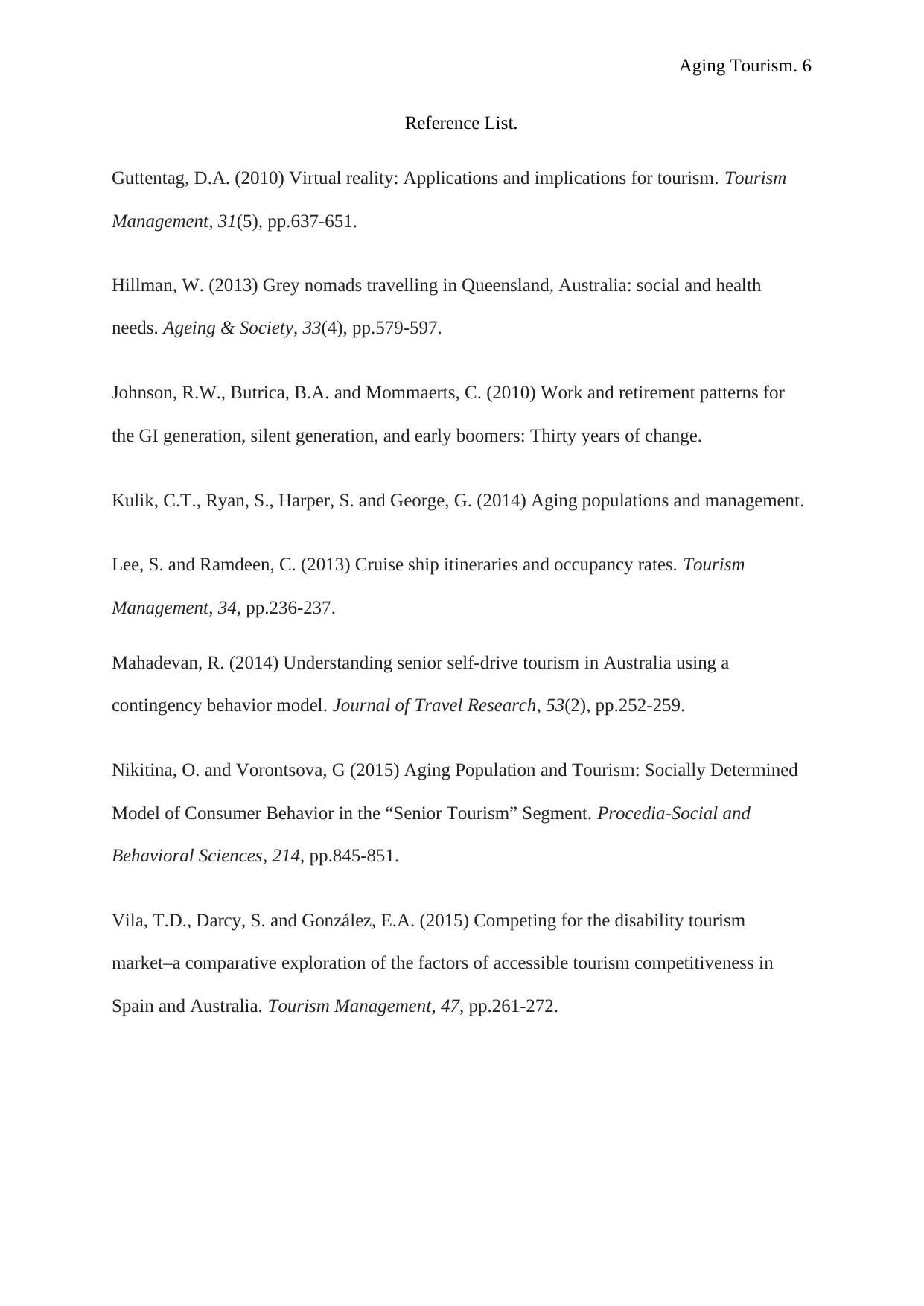
Aging Tourism. 6
Reference List.
Guttentag, D.A. (2010) Virtual reality: Applications and implications for tourism. Tourism
Management, 31(5), pp.637-651.
Hillman, W. (2013) Grey nomads travelling in Queensland, Australia: social and health
needs. Ageing & Society, 33(4), pp.579-597.
Johnson, R.W., Butrica, B.A. and Mommaerts, C. (2010) Work and retirement patterns for
the GI generation, silent generation, and early boomers: Thirty years of change.
Kulik, C.T., Ryan, S., Harper, S. and George, G. (2014) Aging populations and management.
Lee, S. and Ramdeen, C. (2013) Cruise ship itineraries and occupancy rates. Tourism
Management, 34, pp.236-237.
Mahadevan, R. (2014) Understanding senior self-drive tourism in Australia using a
contingency behavior model. Journal of Travel Research, 53(2), pp.252-259.
Nikitina, O. and Vorontsova, G (2015) Aging Population and Tourism: Socially Determined
Model of Consumer Behavior in the “Senior Tourism” Segment. Procedia-Social and
Behavioral Sciences, 214, pp.845-851.
Vila, T.D., Darcy, S. and González, E.A. (2015) Competing for the disability tourism
market–a comparative exploration of the factors of accessible tourism competitiveness in
Spain and Australia. Tourism Management, 47, pp.261-272.
Reference List.
Guttentag, D.A. (2010) Virtual reality: Applications and implications for tourism. Tourism
Management, 31(5), pp.637-651.
Hillman, W. (2013) Grey nomads travelling in Queensland, Australia: social and health
needs. Ageing & Society, 33(4), pp.579-597.
Johnson, R.W., Butrica, B.A. and Mommaerts, C. (2010) Work and retirement patterns for
the GI generation, silent generation, and early boomers: Thirty years of change.
Kulik, C.T., Ryan, S., Harper, S. and George, G. (2014) Aging populations and management.
Lee, S. and Ramdeen, C. (2013) Cruise ship itineraries and occupancy rates. Tourism
Management, 34, pp.236-237.
Mahadevan, R. (2014) Understanding senior self-drive tourism in Australia using a
contingency behavior model. Journal of Travel Research, 53(2), pp.252-259.
Nikitina, O. and Vorontsova, G (2015) Aging Population and Tourism: Socially Determined
Model of Consumer Behavior in the “Senior Tourism” Segment. Procedia-Social and
Behavioral Sciences, 214, pp.845-851.
Vila, T.D., Darcy, S. and González, E.A. (2015) Competing for the disability tourism
market–a comparative exploration of the factors of accessible tourism competitiveness in
Spain and Australia. Tourism Management, 47, pp.261-272.
⊘ This is a preview!⊘
Do you want full access?
Subscribe today to unlock all pages.

Trusted by 1+ million students worldwide
1 out of 6
Related Documents
Your All-in-One AI-Powered Toolkit for Academic Success.
+13062052269
info@desklib.com
Available 24*7 on WhatsApp / Email
![[object Object]](/_next/static/media/star-bottom.7253800d.svg)
Unlock your academic potential
Copyright © 2020–2025 A2Z Services. All Rights Reserved. Developed and managed by ZUCOL.





